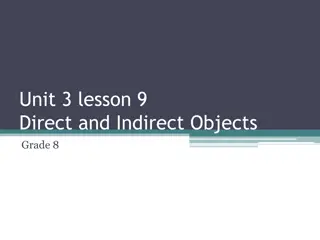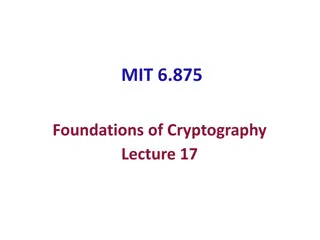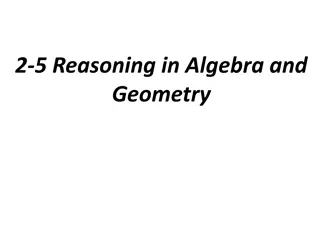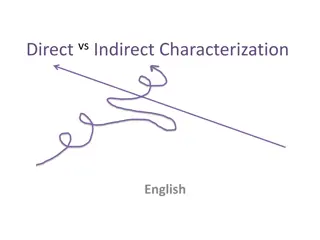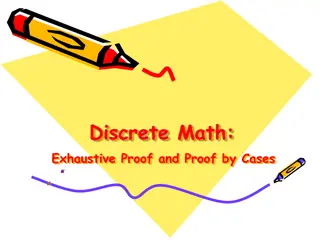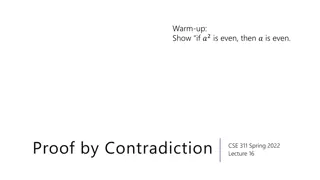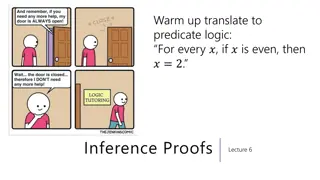Understanding Indirect Proofs: Contradiction and Contraposition Examples
Indirect proofs offer a roundabout approach to proving statements, with argument by contradiction and argument by contraposition being the main techniques. Argument by contradiction involves supposing the statement is false and deriving a contradiction, while argument by contraposition relies on the logical equivalence between a statement and its contrapositive. These methods are illustrated with examples showing the power of indirect reasoning in mathematical proofs.
Download Presentation

Please find below an Image/Link to download the presentation.
The content on the website is provided AS IS for your information and personal use only. It may not be sold, licensed, or shared on other websites without obtaining consent from the author. Download presentation by click this link. If you encounter any issues during the download, it is possible that the publisher has removed the file from their server.
E N D
Presentation Transcript
Indirect Argument: Contradiction and Contraposition In a direct proof you start with the hypothesis of a statement and make one deduction after another until you reach the conclusion. Indirect proofs are more roundabout. One kind of indirect proof, argument by contradiction, is based on the fact that either a statement is true or it is false but not both. So if you can show that the assumption that a given statement is not true leads logically to a contradiction, impossibility, or absurdity, then that assumption must be false: and, hence, the given statement must be true. 1
Indirect Argument: Contradiction and Contraposition The point of departure for a proof by contradiction is the supposition that the statement to be proved is false. The goal is to reason to a contradiction. Thus proof by contradiction has the following outline: 2
Example 1 Solution cont d Proof: [We take the negation of the theorem and suppose it to be true.] Suppose not. That is, suppose there is a greatest integer N. [We must deduce a contradiction.] 3
Example 1 Solution cont d Then N n for every integer n. Let M = N + 1. Now M is an integer since it is a sum of integers. Also M > N since M = N + 1. Thus M is an integer that is greater than N. So N is the greatest integer and N is not the greatest integer, which is a contradiction. [This contradiction shows that the supposition is false and, hence, that the theorem is true.] 4
Indirect Argument: Contradiction and Contraposition The fact that no integer can be both even and odd follows from the uniqueness part of the quotient-remainder theorem. It can be proved by contradiction as well. 5
Argument by Contraposition A second form of indirect argument, argument by contraposition, is based on the logical equivalence between a statement and its contrapositive. To prove a statement by contraposition, you take the contrapositive of the statement, prove the contrapositive by a direct proof, and conclude that the original statement is true. The underlying reasoning is that since a conditional statement is logically equivalent to its contrapositive, if the contrapositive is true then the statement must also be true. 6
Example 4 If the Square of an Integer Is Even, Then the Integer Is Even Prove that for all integers n, if n2 is even then n is even. Solution: First form the contrapositive of the statement to be proved. Contrapositive:For all integers n, if n is not even then n2 is not even. That is, for all integers n, if n is odd then n2 is odd. 8
Example 4 cont d Proof (by contraposition): We prove the contrapositive. Suppose n is any odd integer. [We must show that n2 is odd.] By definition of odd, n = 2k + 1 for some integer k. By substitution and algebra, But 2k2 + 2k is an integer because products and sums of integers are integers. So n2 = 2 (an integer) + 1, and thus, by definition of odd, n2 is odd [as was to be shown]. 9
Propositions vs. Theorems We used the word proposition here rather than theorem because although the word theorem can refer to any statement that has been proved, mathematicians often restrict it to especially important statements that have many and varied consequences. Then they use the word proposition to refer to a statement that is somewhat less consequential but nonetheless worth writing down. 10
Relation between Proof by Contradiction and Proof by Contraposition Observe that any proof by contraposition can be recast in the language of proof by contradiction. In a proof by contraposition, the statement is proved by giving a direct proof of the equivalent statement 11
Relation between Proof by Contradiction and Proof by Contraposition To do this, you suppose you are given an arbitrary element x of D such that ~Q(x). You then show that ~P(x). Proof by Contraposition Exactly the same sequence of steps can be used as the heart of a proof by contradiction for the given statement. The only thing that changes is the context in which the steps are written down. 12
Relation between Proof by Contradiction and Proof by Contraposition To rewrite the proof as a proof by contradiction, you suppose there is an x in D such that P(x) and ~Q(x). You then follow the steps of the proof by contraposition to deduce the statement ~P(x). But ~P(x) is a contradiction to the supposition that P(x) and ~Q(x). (Because to contradict a conjunction of two statements, it is only necessary to contradict one of them.) This process is illustrated in Figure 4.6.2. Proof by Contradiction Figure 4.6.2 13
Relation between Proof by Contradiction and Proof by Contraposition As an example, here is a proof by contradiction of Proposition 4.6.4, namely that for any integer n, if n2 is even then n is even. Proof (by contradiction): [We take the negation of the theorem and suppose it to be true.] Suppose not. That is, suppose there is an integer n such that n2 is even and n is not even. [We must deduce a contradiction.] 14
Relation between Proof by Contradiction and Proof by Contraposition By the quotient-remainder theorem with d = 2, any integer is even or odd. Hence, since n is not even it is odd, and thus, by definition of odd, n = 2k + 1 for some integer k. By substitution and algebra: But 2k2 + 2k is an integer because products and sums of integers are integers. So n2 = 2 (an integer) + 1, and thus, by definition of odd, n2 is odd. Therefore, n2 is both even and odd. 15
Relation between Proof by Contradiction and Proof by Contraposition This contradicts Theorem 4.6.2, which states that no integer can be both even and odd. [This contradiction shows that the supposition is false and, hence, that the proposition is true.] 16
Relation between Proof by Contradiction and Proof by Contraposition Note that when you use proof by contraposition, you know exactly what conclusion you need to show, namely the negation of the hypothesis; whereas in proof by contradiction, it may be difficult to know what contradiction to head for. On the other hand, when you use proof by contradiction, once you have deduced any contradiction whatsoever, you are done. 17
Relation between Proof by Contradiction and Proof by Contraposition The disadvantage of contraposition as compared with contradiction is that you can use contraposition only for a specific class of statements those that are universal and conditional. The previous discussion shows that any statement that can be proved by contraposition can be proved by contradiction. But the converse is not true. Statements such as is irrational can be proved by contradiction but not by contraposition. 18






